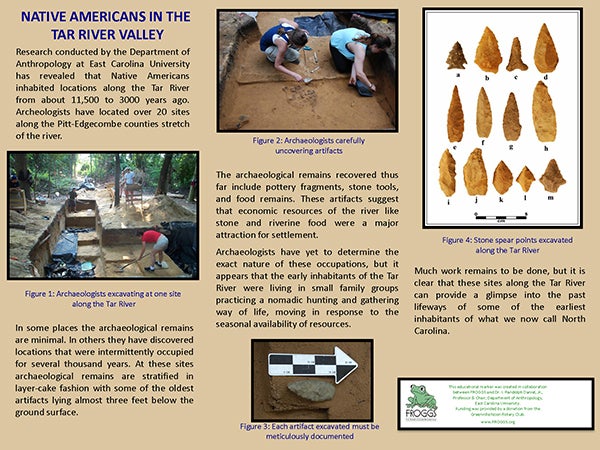Marker along Greenville Greenway recognizes Native American inhabitants of Tar River
History and recreation will come together along the Greenville Greenway thanks to East Carolina University faculty members and a local nonprofit group.

The new historical marker made possible by ECU professors and the local nonprofit Friends of Greenville Greenways (FROGGS) sits near the Toyota Amphitheater at the Town Common in downtown Greenville. (Contributed photos)
Dr. Randy Daniel, chair of ECU’s Department of Anthropology, has partnered with the local nonprofit organization Friends of Greenville Greenways (FROGGS) and its founder, Jill Twark, associate professor of German in the Department of Foreign Languages and Literatures, to produce an educational marker documenting archaeological excavations along the Tar River that revealed Native American settlements.
According to Daniel, Native Americans inhabited locations along the Tar River from about 11,500 to 3,000 years ago. As part of Daniel’s archaeological research, performed during summer field schools over several summers, archaeologists and students located more than 20 Native American settlements along the stretch of the river within Pitt and Edgecombe counties. Some of the oldest occupations were discovered almost 3 feet below the ground surface.
“What we found at these sites consisted largely of stone tools such as spear and arrow points, cutting and scraping tools and their manufacturing debris, along with pottery sherds,” he said. “In particular, it appeared that small quartz cobbles were procured from the river and used as raw material to make tools and weapons.
“Given that these sites were intermittently occupied for several thousand years, we documented certain changes in artifact styles over time. Pottery didn’t appear until late in the occupational sequence. We estimated its presence at about 3,000 years ago,” Daniel said.
“Because artifacts and other objects remaining from the Native American settlements along the Tar River are buried underground and thus otherwise not visible to us, it is essential to engage in archeological excavations to reveal this history,” Twark said. “Educational markers like this one allow anyone walking or playing at the Town Common to stop for a few minutes and reflect on ancient indigenous cultures not knowable from written accounts. They are accessible, tiny museums requiring no entrance fee to enjoy and learn from.”

ECU students carefully uncover a cluster of stone artifacts along the Tar River during the 2014 anthropology summer field school.

Stone spear points excavated along the Tar River.

ECU students and archaeologists excavate at a site along the Tar River during the 2014 anthropology summer field school.
The new historical marker was funded by the Greenville Noon Rotary Club in collaboration with FROGGS and was installed by the Greenville Recreation and Parks Department near the Toyota Amphitheater at the Town Common in downtown Greenville.
If you have an idea for a topic to include on a future educational marker or would like to provide content and photographs to create one, contact Twark at twarkj@ecu.edu. FROGGS is seeking topics related to West Greenville and local African American history connected to the Tar River in anticipation of the West Greenville Greenway extension – Phase 3a of the South Tar River Greenway – scheduled to be completed this fall.

ECU students uncovered a 4,000- to 5,000-year-old hearth during the 2014 anthropology summer field school.